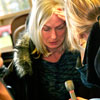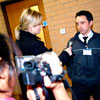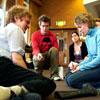News & Events
 |
Could you cover a bomb attack in London? Our MA Multi-Media Journalism students take part in a unique exercise |
Sunday afternoon, minutes before kick-off. Chelsea need just one point against Arsenal to win the league title for the second year running. The mood in west London is festive as the capacity crowd waits for the show-down of the season.
Suddenly, the atmosphere is punctured by a loud explosion. Within minutes it is clear that the worst fears have come true. Terror has again come to the capital.
As the crowd spills onto the Stamford Bridge pitch, the extent of the casualties becomes plain to see. Newsrooms across London, picking up the dramatic live television pictures, send in reinforcements to cover the breaking news story.
This is where The Media School's students come in. For this is, thankfully, an exercise, staged on the university campus, with professional actors playing four key roles as victims and witnesses in the unfolding drama of a terror attack.
 |
The exercise was part of a pioneering programme to introduce masters students on the Media School's MA Multi-Media Journalism course to the subject of media and trauma. |
The students' job was to cover the story and, later, to reflect on the many complex issues raised by such a traumatic news event.
How do you interview a victim clearly in shock (do you even attempt to do so?); where is the dividing line between the need to get the story and human compassion; what impact does such a story have on the journalists covering it; what are their emotions and thoughts?
The exercise was part of a pioneering programme to introduce masters students on The Media School's MA Multi-Media Journalism course to the subject of media and trauma. And as the exercise was designed to show, these are not issues confined to the hardened war correspondent. Every journalist can face them any day of their career, whether it be a terror attack or a road accident.
The programme was led by Mark Brayne, a former BBC foreign correspondent who heads the European arm of the Dart Centre for Journalism and Trauma, a global network of journalists, journalism educators and health professionals dedicated to improving coverage of trauma, conflict and tragedy.
 |
The programme was led by Mark Brayne, a former BBC foreign correspondent who heads the European arm of the Dart Centre for Journalism and Trauma |
The Media School is moving into uncharted territory in the academic world and the students were pioneers. No other journalism course in UK universities is known to have introduced such a comprehensive programme in a subject area which is relatively new to the media profession itself.
"We have started to gather valuable experience with some of the big professional media outlets,"said Brayne. "But the Bournemouth sessions were a first in the academic world in this country, and indeed in Europe, and should set a benchmark for how we can educate the next generation of journalists."
"We are guinea pigs – it is interesting and positive for the course because it shows the course is on its toes…"said one of the international students, Sigridur Gudlaugsdottir.
In the first session, in which students were given an overview of the subject, it soon became clear that this was not some form of psychobabble. Fundamental moral and ethical issues were raised. Why did, for example, The Times and some other newspapers print a picture of a lawyer jumping to her death in a London street?
 |
"...It is interesting and positive for the course because it shows the course is on its toes…"said one of the international students, Sigridur Gudlaugsdottir. |
For the second session, the Student Centre became a mock Stamford Bridge. The 20-odd students had divided up into four news teams, each with one discipline: print, web, radio and television. It was their task to gather the news by interviewing the four victims and witnesses – the actors.
Those actors had rehearsed in detail the roles and personalities of four key characters – a victim injured in the blast, a St John Ambulance worker traumatised by what she had seen, a guilt-ridden security guard (who may have been responsible for a security lapse) and a distraught father searching for his missing son.
The students knew they had to get the story. But just how was a matter of learning on the job. It became clear pretty quickly that thrusting cameras and tripods in the face of a bomb victim is not the way to gather information from someone who is traumatised.
When the exercise was finished, the actors said it was the small things that had made them open up and speak more freely to the reporting teams. One student offered her mobile phone to the angry father to help him contact the authorities; another cracked a joke with the St John Ambulance worker and gained her confidence.
The teams had three days to produce their finished packages for review at a third and final session. Their work was of a high standard, it was emotive and compelling, without going over the top.
"Once you live the experience, it is very shocking and it moves you,"said another of the students, Eduardo Landin. "It seems you are there in an extreme situation because the actors' performances are so good and that really makes you work on this....”
Related Courses






